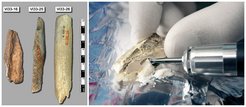Humans and Neanderthals interbred
Analysis of the Neanderthal genome indicates that, contrary to previous beliefs, humans and Neandertals interbred
The first genome sequence from an extinct human relative is now available. Together with an international research team, researchers at the Max Planck Institute for Evolutionary Anthropology in Leipzig present an initial draft of the genome sequence of the Neandertal, a human form which died out some 30,000 years ago. Initial analyses of four billion base pairs of Neandertal DNA indicate that Neandertals left their mark in the genomes of some modern humans. (Science, May 7th 2010)

A unique scientific task lasting four years has been completed: a team of researchers led by Svante Pääbo, Director of the Department of Evolutionary Genetics at the Max Planck Institute for Evolutionary Anthropology in Leipzig, is publishing an initial version of the Neandertal genome sequence in the current issue of the journal Science.
This is an unprecedented scientific achievement: only ten years after the decoding of the present-day Homo sapiens genome, researchers have managed to do something similar for an extinct hominid that was the closest relative of modern humans. "The comparison of these two genetic sequences enables us to find out where our genome differs from that of our closest relative," says Svante Pääbo.
The Neandertal sequence presented is based on the analysis of over one billion DNA fragments taken from several Neandertal bones found in Croatia, Russia and Spain, as well as from the original Neandertal found in Germany. From the DNA fragments present in the bones the Leipzig researchers developed ways to distinguish true Neandertal DNA from the DNA of microbes that have lived in the bones over the last 40,000 years. Enough DNA fragments were retrieved to account for over 60 percent of the entire Neandertal genome.
An initial comparison of the two sequences has brought some exciting discoveries to light. Contrary to the assumption of many researchers, it would appear that some Neandertals and early modern humans interbred. According to the researchers’ calculations, between one and four percent of the DNA of many humans living today originate from the Neandertal. "Those of us who live outside Africa carry a little Neandertal DNA in us," says Svante Pääbo. Previous tests carried out on the DNA of Neandertal mitochondria, which represents just a tiny part of the whole genome, had not found any evidence of such interbreeding or "admixture".
For the purpose of the analysis the researchers also sequenced five present day human genomes of European, Asian and African origin and compared them with the Neandertal. To their surprise they found that the Neandertal is slightly more closely related to modern humans from outside Africa than to Africans, suggesting some contribution of Neandertal DNA to the genomes of present-day non-Africans. Interestingly, Neandertals show the same relationship with all humans outside Africa, whether they are from Europe, East Asia or Melanesia. This is puzzling, as no Neandertal remains have been so far found in East Asia. They lived in Europe and Western Asia.
The researchers offer a plausible explanation for this finding. Svante Pääbo: "Neandertals probably mixed with early modern humans before Homo sapiens split into different groups in Europe and Asia." This could have occurred in the Middle East between 100,000 and 50,000 years ago before the human population spread across East Asia. It is known from archaeological findings in the Middle East that Neandertals and modern humans overlapped in time in this region.

Apart from the question as to whether Neandertals and Homo sapiens mixed, the researchers are highly interested in discovering genes that distinguish modern humans from their closest relative and may have given the modern humans certain advantages over the course of evolution.
By comparing Neandertal and modern human genomes, the scientists identified several genes that may have played an important role in modern human evolution. For example, they found genes related to cognitive functions, metabolism and the development of cranial features, the collar bone and the rib cage. However, more detailed analysis needs to be carried out to enable conclusions to be drawn on the actual influence of these genes.
The research team obtained the majority of the DNA used for their study from a total of 400 milligrams of bone powder, produced from three female Neandertal bones that were excavated from Vindija cave in Croatia where they lived over 38,000 years ago.
Sequencing the genome of a species that died out tens of thousands of years ago posed a very special challenge, as the DNA had disintegrated into tiny fragments over the course of time and suffered other types of chemical damage. A further complication arose in the form of contamination. "Over 95 percent of the DNA in one sample originated from bacteria and microorganisms which colonised the Neandertal after his death," says Svante Pääbo. Human DNA, which can enter the sample during excavation or in the laboratory, could also jeopardize the results. Pääbo and his team in Leipzig used various techniques, some of them completely new, to eliminate the contamination from the DNA to be sequenced. For example, they processed the samples in ultra-clean rooms and marked each DNA fragment from the bone with a short synthetic piece of DNA as a label, to be able to distinguish it from any modern human DNA introduced later in the sequencing process. Crucially, the researchers could show that these anti-contamination measures were effective by careful analysis of the sequence results.
Having overcome the multiple technical challenges, the researchers look optimistically into the future: "We will also decode the remaining parts of the Neandertal genome and learn much more about ourselves and our closest relative," says Svante Pääbo.













